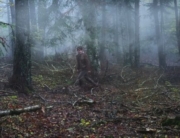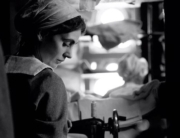The World of Kanako is not a film that produces a lukewarm reaction. It’s pretty much a love or hate kind of situation. Of course, you can do both. Connections to films can be like relationships, and this is one you can absolutely despise loving. In fact, it’s a response the movie practically demands.
There is not one single likable character in Kanako. Akikazu Fujishima (Koji Yakusho) is an abhorrent human being, a self-centered, violent misogynist who rapes, murders, and terrorizes anyone in his path. His daughter, Kanako (Nana Komatsu), is demonstrably worse. Director Tetsuya Nakashima barely lets you know these depraved characters enough to suss out their motivations as they rampage through a just-barely more welcoming world. But when he does, the film’s breathtaking and possibly justifies journeying through the violent, stylized, darkly humorous world Nakashima has created.
The movie begins with a triple murder at a deli that Akikazu frequents. He was a first-class detective who was dismissed for alcoholism and erratic behavior. Akikazu now spends his days as a security guard and his nights at bars and ramen stands downing meds with bourbon and beer. He soon gets a call from his ex-wife that Kanako (whom he hasn’t seen in years) has been missing for five days. Searching her room, he finds a cache of heroin, which sets of his desire to search for her.
A very good detective (save for his tendency to rough up everyone he questions), Akikazu makes a connection between the murder at the beginning of the film and Kanako’s disappearance. The further he searches, the more he spirals down into a cesspool of human depravity, and the more unhinged and violent he becomes. His story parallels a nameless 15-year-old boy (Hiroya Shimizu) that Kanako saves from vicious bullies three years earlier. This fairly plaintive romantic narrative contrasts with the ultraviolence throughout, but even this light is snuffed out as naiveté gives way to bitter experience and murderous impulses.
As we move along, the mystery deepens and involves us despite the utter depravity of everyone involved. We see glimpses of humanity occasionally, but the dark side is strong in the world Nakashima has created. As a result, this is not an easy film to digest, though Nakashima helps us along with some expert filmmaking and a rollicking style that is reminiscent of ’60’s exploitation flicks (with more than a touch of Tarantino). There are some bravura sequences, too: the shoot/knife out on the top of a parking garage is particularly virtuosic. And just when you had enough, and there is a lot to have enough of, the last third slows down as Akikazu solves the case and you realize you have essentially been watching some weird existential novel come to life (quite literally, the script was adapted from a novel). Nakashima gives Akikazu time to reflect—while taking someone hostage, of course. Old habits die hard. The final frame and line is a splash of ice cold water on all the funky shootouts and bravado and generally cool filmmaking that came before it. There is a deadly serious artist at work here.
Again, this is a massively violent film. No one is safe. No one is good. There are two graphic rape scenes that Nakashima handles with astonishing nonchalance. It’s not that he doesn’t show sympathy for the victims, but the film is told through Akikazu’s point of view, and the detective is way past gone in terms of moral relativism. It hammers home how one’s own self-loathing and hatred can do tremendous, irreparable damage to the populace at large and, more importantly, to one’s own family.
















Leave A Comment